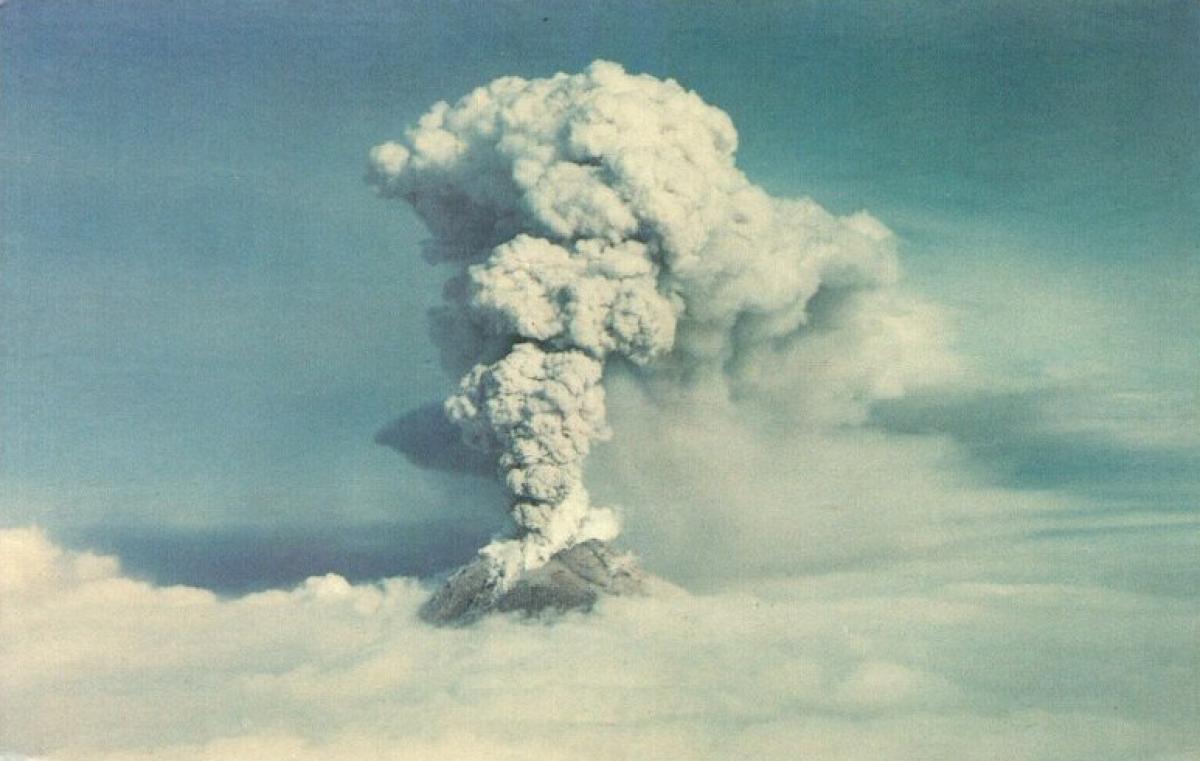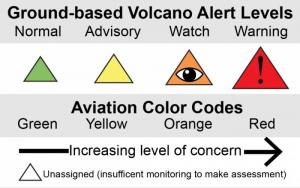-
About Homer
-
- Americans with Disabilities Act Compliance Program City Campgrounds Community Recreation Hickerson Memorial Cemetery
- Library Parks & Trails Public Safety Fire Police Emergency Information
- Events & Activities City Calendar Library Calendar Recreation Calendar Doing Business in Homer Sister City Program Coast Guard City
-
- Departments
- Government
- How Do I?
Volcano Preparedness

There are four monitored volcanoes in the Kenai Peninsula Borough: Spurr, Redoubt, Iliamna and Augustine. Their activity is monitored by the Alaska Volcano Observatory (AVO), a joint program of the U.S. Geological Survey, the Geophysical Institute of the University of Alaska Fairbanks, and the State of Alaska Division of Geological and Geophysical Surveys.

| Green | Normal | Volcano is within typical range of background activity, non-eruptive state | |
| Yellow | Advisory | Volcano is exhibiting signs of elevated unrest above known background levels, or activity has decreased from a higher level | AVO closely monitors situation |
| Orange | Watch | Volcano is exhibiting heightened or escalating unrest with increased potential of eruption, timeframe uncertain, OR eruption is underway but poses limited hazards | Increased potential for eruption, though timeframe uncertain |
| Red | Warning | Hazardous eruption is imminent, underway or suspected with significant emission of ash into the atmosphere |
Highest alert level requiring immediate attention |
A volcano eruption may be unpredictable but being prepared isn't.
Here are some steps to help you be prepared for potential volcanic ash fallout.
Volcanic ash is is made of very tiny sharp pieces of rock and glass, and freshly fallen ash particles have acid coatings which is rapidly removed by rain. Both these characteristics are hard on equipment and appliances, and can irritate lungs and eyes. Respiratory effects of ash include nose, throat and airway irritation. Folks with pre-existing respiratory conditions are most at risk and should be especially cautious. Eye irritation is a common health effect as gritty ash can cause painful scratches on the surface of your eye. And while not very common, volcanic ash can irritate your skin, especially if the ash is acidic or particularly abrasive.
Preparing for Volcanic Ash:
- Make an emergency kit, include items specific to volcanic ash fall such as:
- Goggles
- N95 dust mask (If no mask is available use a damp cloth)
- Gloves
- Tyvek suit (if you need to go or work outside during or immediately after ash fall)
- Plastic sheeting (2-4 mil thick) and duct tape to seal windows, door sills and vents
- Extra vacuum cleaner bags and air filters
- Replenish or purchase a home emergency first aid kit
- Make an emergency plan (for you, your family, your pets and your home)
- Your family may not be together; a plan will help you know how you'll contact one another and reconnect
- Check into any appliance or device that utilizes outside air during its operation (for example, heaters, heat recovery ventilation systems, appliance vents). These systems may pull air from outside for combustion, which could damage the appliance if ash is in the air. Review manufacturer guidelines on protecting these systems from ash.
- Get connected to stay informed
- Register for KPB Alerts to get notifications: My KPB
- Sign up for the U.S. Geological Survey (USGS) Volcano Notification Service. It is free email service you can customize to get notices for volcanoes in your area.
- Learn more about volcanic ash. Check out Guidelines on Preparedness Before, During and After an Ashfall published by the Internatinal Volcanic Health Hazard Network, Cities and Volcanoes Comission, GNS Science and the United States Geological Survey. It details procedures to follow if warning of a volcanic ash fall is given, recommends what to do during ash fall, and what methods are most effective for cleaning up volcanic ash after the event.
During Volcanic Ash Event:
- Protect yourself, your family and pets
- If possible, stay indoors until local health officials advise it is safe to go outside
- Prevent ash entering your home
- Keep windows and doors closed
- Place damp towels at door thresholds; seal entrances and openings (doors, windows, dampers)
- Select an entry point that can be used as an 'ash lock', ideally two sets of doors separated by a space like an arctic entryway where you can leave ash-covered clothing and shoes
- Keep pets indoors as much as possible
- Brush or vacuum them when coming back inside
- Make sure their water dishes are protected from ash fall
- If possible, do not drive, ash is very hard on vehicles
- If you have to go outside:
- Wear long-sleeved shirts and long pants
- Use goggles to protect your eyes
- Wear eyeglasses instead of contact lenses
- Use a dust mask (N-95 recommended) or hold a damp cloth over your face to assist in breathing
- Protect water storage
- If you use a rainwater collection system for your water supply, disconnect from the tank prior to ash falling
- Cover wells and water tanks exposed to ash with secured plastic sheeting
- Turn off outdoor water pumps that lack proper filtration
- Protect your home, appliances and equipment
- Cover/close external air intakes
- Unplug back-up generator systems that are on a transfer switch. These turn on automatically when the power goes out. They won’t last long if they’re taking in ash.
- Shut down and cover exposed, non-essential equipment where possible
- Stay updated
- Listen to local officials for important information
After a Volcanic Ash event:
- Check on neighbors
- When outside, protect yourself from the fine, glassy particles of volcanic ash
- Cover your mouth and nose
- Wear goggles to protect your eyes
- Wear eyeglasses instead of contact lenses
- Keep skin covered to avoid irritation from contact with ash
- Don't dry sweep
- Lightly water down ash deposits before they are removed by shoveling
- Use a damp cloth to prevent ash from going airborne
- Clean vehicles with water; if you dry wipe, the ash can scratch your car
- Check that ash is not clogging drainage on flat roofs. Heavy ash combined with rain could collapse a roof
Keep informed of the Volcano Activity in our region by checking the Alaska Volcano Observatory website regularly for updates.


